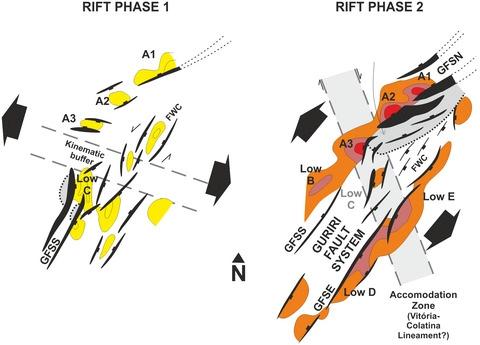当前位置:
X-MOL 学术
›
Basin Res.
›
论文详情
Our official English website, www.x-mol.net, welcomes your
feedback! (Note: you will need to create a separate account there.)
Tectono-stratigraphic evolution of the rift and post-rift systems in the Northern Campos Basin, offshore Brazil
Basin Research ( IF 2.8 ) Pub Date : 2022-04-29 , DOI: 10.1111/bre.12674 Michael Strugale 1, 2 , Joe Cartwright 2
Basin Research ( IF 2.8 ) Pub Date : 2022-04-29 , DOI: 10.1111/bre.12674 Michael Strugale 1, 2 , Joe Cartwright 2
Affiliation

|
The Campos and Santos Basins have been a focus of subsurface studies since the discovery in 2006 of large accumulations of hydrocarbons in the Early Cretaceous rift and post-rift strata below Aptian evaporites. In this study, regional 2D seismic lines, a 3D seismic survey and well data were interpreted to reconstruct the tectono-stratigraphic evolution of the rift and post-rift stages in the northern sector of the Campos Basin. Detailed 3D seismic interpretation and geological modelling were used to subdivide the pre-salt sedimentary record. This revealed a diachronous strain distribution along the Guriri Fault System (GFS), a roughly NE-SW striking fault-bounded horst that was a focus of rift-related deformation. The syn-rift succession is interpreted to be the product of two episodes of rifting (RP1 and RP2) with contrasting fault activity patterns and lithostratigraphy. Volcaniclastics and coarse siliciclastics of RP1 were deposited under WNW-ESE transtension that formed discontinuous half-grabens followed by extensive erosion and tectonic inversion. Structurally controlled bioclastic rudstones and hybrid deposits characterize RP2 and were deposited in elongated half-grabens that delimit the GFS horst, which developed under an NW-SE extension. Deposition under increasingly less tectonically active transitional and post-rift stages dominated by thermal subsidence gradually led to the healing of the rift-related structural relief. Selective reactivation of rift faults testifies active tectonic inversion through compression from immediate post-rift throughout evaporite deposition. These interpretations are put into the context of recent geochronological data of onshore dyke emplacement and the new age constraints for the end of deposition of the pre-salt sequence. Therefore, we propose an earlier onset on rifting in the Campos Basin, at the Berriasian.
中文翻译:

巴西近海北坎波斯盆地裂谷和裂谷后系统的构造地层演化
自 2006 年在早白垩世裂谷和裂谷后地层中发现大量油气聚集以来,坎波斯盆地和桑托斯盆地一直是地下研究的焦点。在这项研究中,区域 2D 地震线、3D 地震勘测和井数据被解释为重建 Campos 盆地北部裂谷和裂谷后阶段的构造地层演化。详细的 3D 地震解释和地质建模用于细分盐下沉积记录。这揭示了沿古里里断层系统 (GFS) 的穿时应变分布,这是一个大致 NE-SW 突出的断层边界地垒,是裂谷相关变形的焦点。同裂谷序列被解释为两个裂谷事件(RP1 和 RP2)的产物,具有对比的断层活动模式和岩石地层。RP1的火山碎屑和粗硅质碎屑在WNW-ESE张紧作用下沉积,形成不连续的半地堑,随后发生广泛的侵蚀和构造反转。结构控制的生物碎屑岩屑岩和混合沉积物是 RP2 的特征,它们沉积在细长的半地堑中,这些地堑界定了 GFS 地垒,该地垒是在 NW-SE 延伸下发育的。在以热沉降为主的构造活动逐渐减弱的过渡阶段和裂谷后阶段的沉积逐渐导致与裂谷相关的构造起伏的愈合。裂谷断层的选择性重新激活通过整个蒸发岩沉积过程中裂谷后立即的压缩证明了活跃的构造反转。这些解释被置于最近陆上堤坝就位的年代学数据和盐下层序沉积结束的新时代约束的背景下。因此,我们建议在 Berriasian 的 Campos 盆地裂谷发生较早。
更新日期:2022-04-29
中文翻译:

巴西近海北坎波斯盆地裂谷和裂谷后系统的构造地层演化
自 2006 年在早白垩世裂谷和裂谷后地层中发现大量油气聚集以来,坎波斯盆地和桑托斯盆地一直是地下研究的焦点。在这项研究中,区域 2D 地震线、3D 地震勘测和井数据被解释为重建 Campos 盆地北部裂谷和裂谷后阶段的构造地层演化。详细的 3D 地震解释和地质建模用于细分盐下沉积记录。这揭示了沿古里里断层系统 (GFS) 的穿时应变分布,这是一个大致 NE-SW 突出的断层边界地垒,是裂谷相关变形的焦点。同裂谷序列被解释为两个裂谷事件(RP1 和 RP2)的产物,具有对比的断层活动模式和岩石地层。RP1的火山碎屑和粗硅质碎屑在WNW-ESE张紧作用下沉积,形成不连续的半地堑,随后发生广泛的侵蚀和构造反转。结构控制的生物碎屑岩屑岩和混合沉积物是 RP2 的特征,它们沉积在细长的半地堑中,这些地堑界定了 GFS 地垒,该地垒是在 NW-SE 延伸下发育的。在以热沉降为主的构造活动逐渐减弱的过渡阶段和裂谷后阶段的沉积逐渐导致与裂谷相关的构造起伏的愈合。裂谷断层的选择性重新激活通过整个蒸发岩沉积过程中裂谷后立即的压缩证明了活跃的构造反转。这些解释被置于最近陆上堤坝就位的年代学数据和盐下层序沉积结束的新时代约束的背景下。因此,我们建议在 Berriasian 的 Campos 盆地裂谷发生较早。











































 京公网安备 11010802027423号
京公网安备 11010802027423号